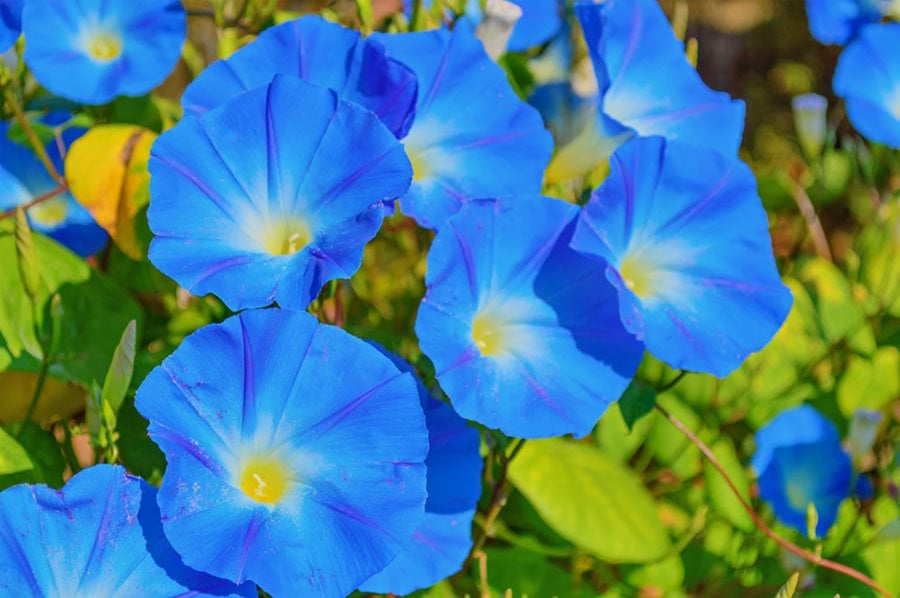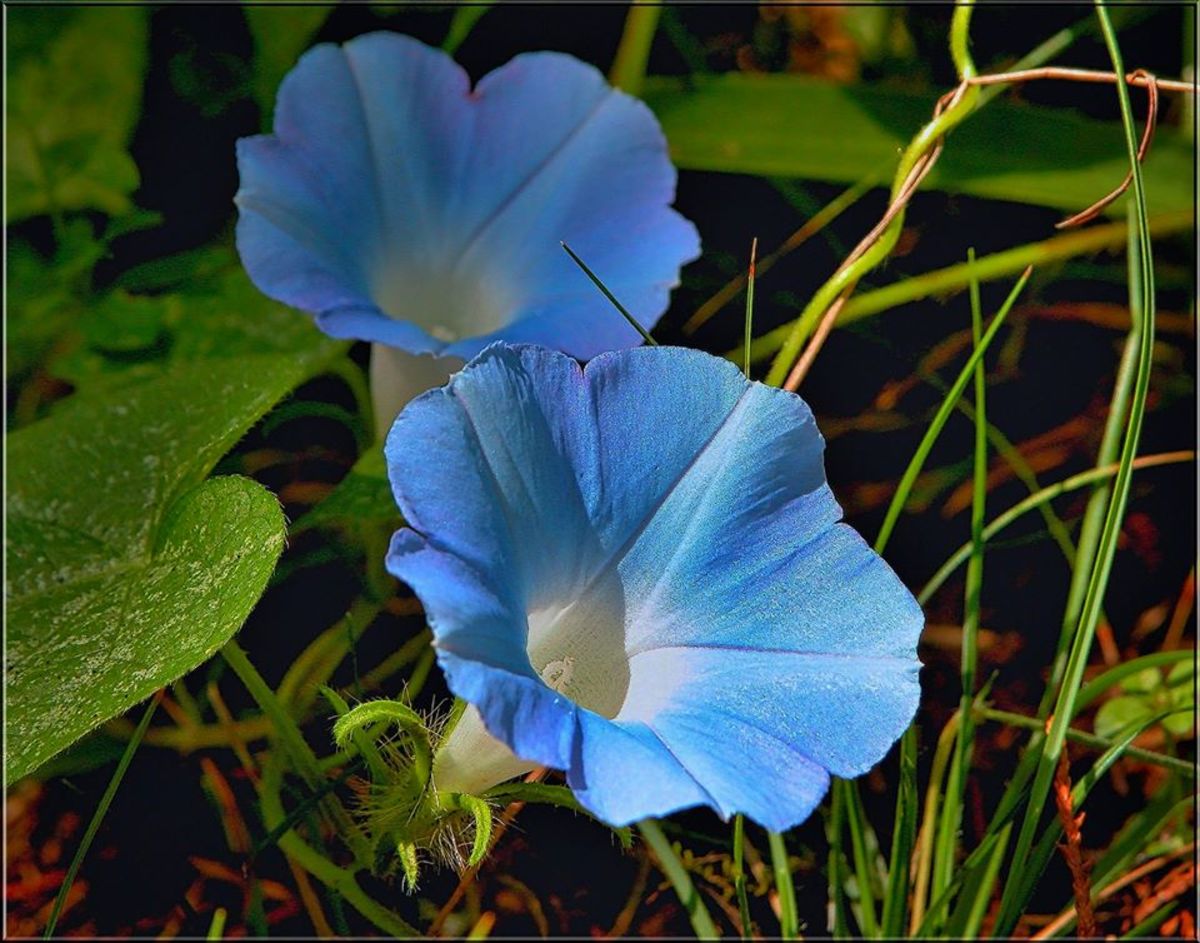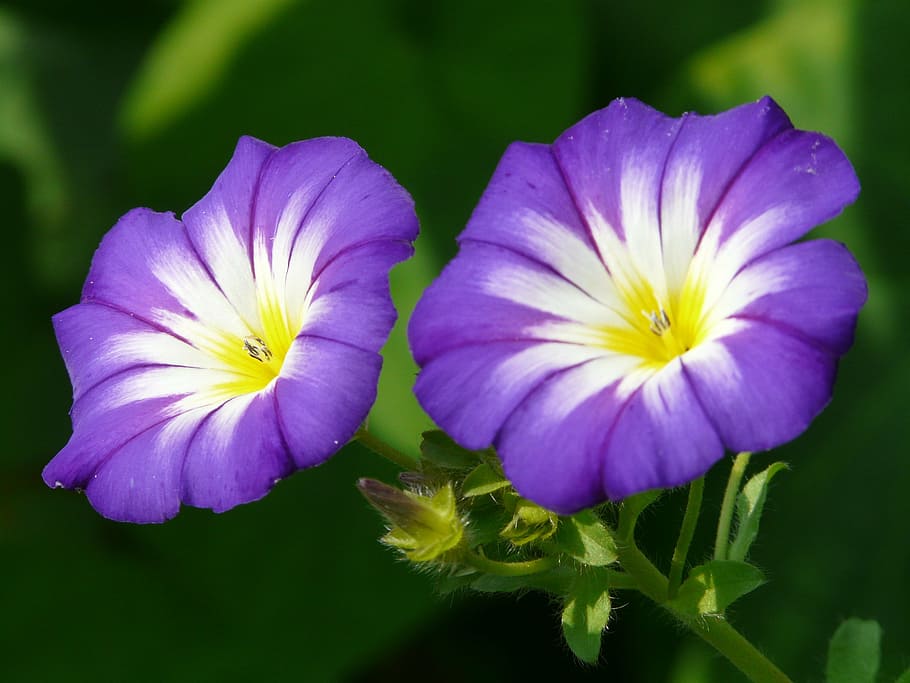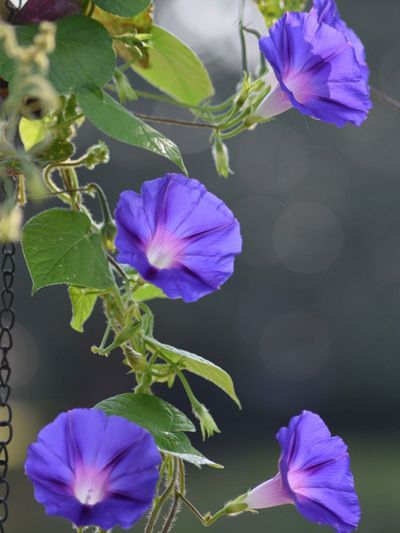Choosing the Right Varieties for Your Morning Glory Display
With so many beautiful varieties of blue and purple morning glories to choose from, selecting the right ones for your garden can be a daunting task. However, by considering a few key factors, you can make an informed decision and create a stunning display that showcases these gorgeous flowers.
One of the most popular varieties of blue morning glories is ‘Heavenly Blue’, which produces large, sky-blue flowers with a delicate white center. Another popular variety is ‘Blue Star’, which produces smaller, star-shaped flowers in a range of blue shades. For a more vibrant display, consider ‘Grandpa Ott’, a purple morning glory variety that produces large, trumpet-shaped flowers with a rich, plum-like color.
When selecting varieties, it’s also important to consider your specific climate and garden conditions. If you live in a cooler climate, look for varieties that are bred to thrive in cooler temperatures, such as ‘Purple Majesty’. If you live in a warmer climate, consider varieties that are heat-tolerant, such as ‘Heavenly Blue’.
In addition to climate and temperature, also consider the amount of sunlight your garden receives. Blue and purple morning glories generally require full sun to partial shade, so choose varieties that are suitable for your garden’s sunlight conditions.
By considering these factors and selecting the right varieties for your garden, you can create a stunning display of blue and purple morning glories that will add beauty and elegance to your outdoor space.
How to Create a Thriving Morning Glory Environment
Blue and purple morning glories are relatively easy to grow, but they do require a specific environment to thrive. By providing the right conditions, you can encourage healthy growth, vibrant blooms, and a stunning display of these beautiful flowers.
Soil preparation is essential for blue and purple morning glories. These flowers prefer well-draining soil that is rich in organic matter. To create a suitable soil environment, mix in a 2-inch layer of compost or well-rotted manure into the top 6-8 inches of soil. This will help to improve soil structure, fertility, and drainage.
Blue and purple morning glories also require full sun to partial shade. Choose a location that receives at least 6 hours of direct sunlight per day, but also provides some shade during the hottest part of the day. This will help to prevent scorching and promote healthy growth.
Watering is another critical aspect of creating a thriving morning glory environment. Blue and purple morning glories prefer moist soil, but they can be susceptible to overwatering. Water your plants deeply once or twice a week, depending on weather conditions. Avoid getting water on the leaves or flowers to prevent fungal diseases.
In addition to soil, sunlight, and water, blue and purple morning glories also benefit from a balanced fertilizer. Feed your plants with a 10-10-10 fertilizer once a month, following the manufacturer’s instructions. This will provide essential nutrients for healthy growth and blooming.
By creating a suitable environment for your blue and purple morning glories, you can encourage healthy growth, vibrant blooms, and a stunning display of these beautiful flowers. With proper care and attention, your morning glories will thrive and provide a breathtaking display of color and beauty.
The Importance of Support for Climbing Morning Glories
Blue and purple morning glories are climbing plants that require support to grow and thrive. Without proper support, these plants can become leggy and weak, producing fewer blooms and a less impressive display. In this section, we’ll discuss the importance of support for climbing morning glories and provide guidance on how to choose the right support for your plants.
There are several types of support structures that can be used for climbing morning glories, including trellises, arbors, and fences. Trellises are a popular choice because they provide a sturdy framework for the plants to climb on, while also adding a decorative element to the garden. Arbors are another option, providing a more rustic and natural support structure for the plants. Fences can also be used, especially if you have a large area to cover.
When choosing a support structure for your blue and purple morning glories, consider the size and weight of the plants. Climbing morning glories can grow quite large and heavy, so make sure the support structure is sturdy enough to hold the weight of the plants. Also, consider the material of the support structure. Wood and metal are popular choices, but make sure they are weather-resistant and won’t rot or rust over time.
In addition to the type of support structure, also consider the placement of the support. Blue and purple morning glories prefer to climb upwards, so place the support structure near the base of the plants and train the stems to climb up. This will help the plants grow and thrive, producing more blooms and a more impressive display.
By providing the right support for your blue and purple morning glories, you can encourage healthy growth, promote blooming, and create a stunning display of these beautiful flowers. With the right support, your morning glories will thrive and provide a breathtaking display of color and beauty.
Managing Pests and Diseases in Your Morning Glory Garden
Blue and purple morning glories are generally hardy and easy to care for, but like all plants, they can be susceptible to pests and diseases. In this section, we’ll discuss some common pests and diseases that can affect blue and purple morning glories, and provide tips on how to manage them using organic and integrated pest management methods.
Aphids are one of the most common pests that can affect blue and purple morning glories. These small, soft-bodied insects can cause curled or distorted leaves, and can also transmit plant viruses. To manage aphids, use neem oil or insecticidal soap, and make sure to spray the undersides of the leaves where aphids tend to congregate.
Whiteflies are another common pest that can affect blue and purple morning glories. These tiny, winged insects can cause yellowing or stunted leaves, and can also transmit plant viruses. To manage whiteflies, use yellow sticky traps or insecticidal soap, and make sure to spray the undersides of the leaves where whiteflies tend to congregate.
Powdery mildew is a common disease that can affect blue and purple morning glories. This fungal disease can cause a white, powdery coating on the leaves, and can also cause stunted or distorted growth. To manage powdery mildew, use a fungicide specifically designed for powdery mildew, and make sure to remove any infected leaves or stems.
In addition to these specific pests and diseases, it’s also important to maintain good garden hygiene to prevent the spread of disease. Make sure to remove any weeds or debris that can harbor pests or diseases, and avoid overwatering or underwatering your blue and purple morning glories.
By using organic and integrated pest management methods, you can keep your blue and purple morning glories healthy and thriving, and prevent the spread of pests and diseases in your garden.
Encouraging Blooming and Fertilization Tips
Blue and purple morning glories are known for their vibrant blooms, but they can be finicky when it comes to producing flowers. To encourage blooming, it’s essential to provide the right conditions and care. In this section, we’ll discuss some tips on how to promote blooming in blue and purple morning glories, including fertilization tips, deadheading, and pruning techniques.
Fertilization is a crucial aspect of promoting blooming in blue and purple morning glories. These plants are heavy feeders and require a balanced fertilizer that is high in phosphorus to promote blooming. Use a fertilizer that is specifically formulated for flowering plants, and follow the instructions on the label for application rates.
Deadheading is another technique that can encourage blooming in blue and purple morning glories. Deadheading involves removing the spent flowers from the plant, which can help to promote more blooms. Use scissors or pinch off the spent flowers to encourage the plant to produce more blooms.
Pruning is also an essential technique for promoting blooming in blue and purple morning glories. Prune the plant regularly to encourage bushy growth and more blooms. Use pruning shears or pinch off the tips of the stems to encourage branching and more blooms.
In addition to these techniques, it’s also essential to provide the right growing conditions for blue and purple morning glories. These plants prefer full sun to partial shade, and well-draining soil that is rich in organic matter. Make sure to water the plants regularly, but avoid overwatering, which can lead to root rot and other problems.
By following these tips, you can encourage blooming in your blue and purple morning glories and enjoy a vibrant display of flowers all season long.
Combining Blue and Purple Morning Glories with Other Flowers
Blue and purple morning glories are stunning flowers that can add a pop of color and beauty to any garden. However, they can also be combined with other flowers to create a unique and dynamic garden display. In this section, we’ll discuss some ways to combine blue and purple morning glories with other flowers, including complementary colors, textures, and bloom times.
One way to combine blue and purple morning glories with other flowers is to choose complementary colors. For example, blue morning glories can be paired with yellow or orange flowers, such as marigolds or zinnias, to create a bright and cheerful display. Purple morning glories can be paired with pink or white flowers, such as petunias or snapdragons, to create a soft and romantic display.
Another way to combine blue and purple morning glories with other flowers is to consider texture. For example, blue morning glories can be paired with flowers that have a soft, delicate texture, such as baby’s breath or Queen Anne’s lace. Purple morning glories can be paired with flowers that have a bold, statement texture, such as sunflowers or dahlias.
Bloom time is also an important consideration when combining blue and purple morning glories with other flowers. For example, blue morning glories can be paired with flowers that bloom in the spring, such as tulips or daffodils, to create a beautiful and vibrant display. Purple morning glories can be paired with flowers that bloom in the summer, such as black-eyed Susans or cosmos, to create a stunning and dynamic display.
Some other flowers that can be combined with blue and purple morning glories include:
- Red salvia: This flower has a bold, statement color that pairs well with blue and purple morning glories.
- Orange marigolds: These flowers have a bright, cheerful color that pairs well with blue and purple morning glories.
- Pink petunias: These flowers have a soft, delicate color that pairs well with blue and purple morning glories.
- White snapdragons: These flowers have a bold, statement color that pairs well with blue and purple morning glories.
By combining blue and purple morning glories with other flowers, you can create a unique and dynamic garden display that showcases the beauty and versatility of these stunning flowers.
Morning Glory Care and Maintenance for Long-Term Success
Blue and purple morning glories are relatively low-maintenance plants, but they do require some care and maintenance to ensure long-term success. In this section, we’ll discuss some tips on how to care for your blue and purple morning glories, including winter care, propagation, and division techniques.
Winter care is an essential aspect of caring for blue and purple morning glories. In areas with frost, it’s essential to protect the plants from cold temperatures. You can do this by bringing the plants indoors or covering them with a frost blanket. In areas without frost, you can simply cut back the plants to about 6 inches from the ground and mulch around the base.
Propagation is another important aspect of caring for blue and purple morning glories. You can propagate these plants by seed or by division. To propagate by seed, simply sow the seeds indoors 6-8 weeks before the last frost date in your area. To propagate by division, dig up the entire plant in the fall and divide it into smaller sections. Replant the sections in the spring, making sure to water them well.
Division is also an essential aspect of caring for blue and purple morning glories. To divide these plants, dig up the entire plant in the fall and separate the roots. Replant the separated roots in the spring, making sure to water them well.
In addition to these care and maintenance tips, it’s also essential to monitor your blue and purple morning glories for pests and diseases. Regularly inspect your plants for signs of pests or diseases, and take action immediately if you notice any problems.
By following these care and maintenance tips, you can ensure the long-term success of your blue and purple morning glories. With proper care and maintenance, these plants can thrive for years to come, providing a stunning display of color and beauty in your garden.
Morning Glory Care and Maintenance for Long-Term Success
Blue and purple morning glories are relatively low-maintenance plants, but they do require some care and maintenance to ensure long-term success. In this section, we’ll discuss some tips on how to care for your blue and purple morning glories, including winter care, propagation, and division techniques.
Winter care is an essential aspect of caring for blue and purple morning glories. In areas with frost, it’s essential to protect the plants from cold temperatures. You can do this by bringing the plants indoors or covering them with a frost blanket. In areas without frost, you can simply cut back the plants to about 6 inches from the ground and mulch around the base.
Propagation is another important aspect of caring for blue and purple morning glories. You can propagate these plants by seed or by division. To propagate by seed, simply sow the seeds indoors 6-8 weeks before the last frost date in your area. To propagate by division, dig up the entire plant in the fall and divide it into smaller sections. Replant the sections in the spring, making sure to water them well.
Division is also an essential aspect of caring for blue and purple morning glories. To divide these plants, dig up the entire plant in the fall and separate the roots. Replant the separated roots in the spring, making sure to water them well.
In addition to these care and maintenance tips, it’s also essential to monitor your blue and purple morning glories for pests and diseases. Regularly inspect your plants for signs of pests or diseases, and take action immediately if you notice any problems.
By following these care and maintenance tips, you can ensure the long-term success of your blue and purple morning glories. With proper care and maintenance, these plants can thrive for years to come, providing a stunning display of color and beauty in your garden.
Some other tips to keep in mind when caring for your blue and purple morning glories include:
- Watering: Make sure to water your blue and purple morning glories regularly, but avoid overwatering, which can lead to root rot and other problems.
- Fertilization: Fertilize your blue and purple morning glories regularly, using a balanced fertilizer that is high in phosphorus to promote blooming.
- Pruning: Prune your blue and purple morning glories regularly to encourage bushy growth and more blooms.
By following these tips and providing the right care and maintenance, you can enjoy a stunning display of blue and purple morning glories in your garden for years to come.




:max_bytes(150000):strip_icc()/how-to-grow-morning-glories-4125567-05-5ca4ca53dfe348bfbb1f740f6727404a.jpg)




